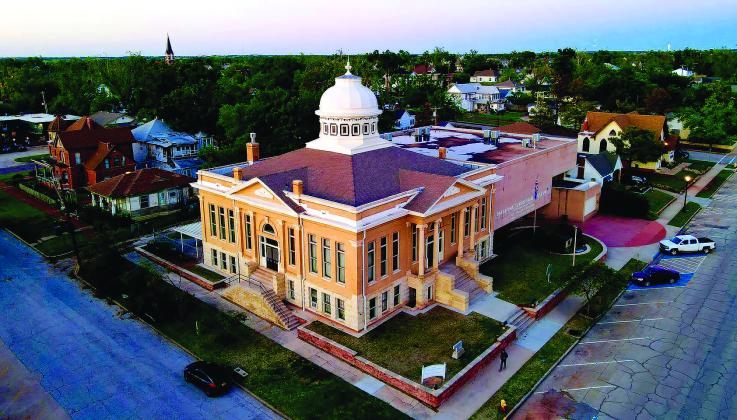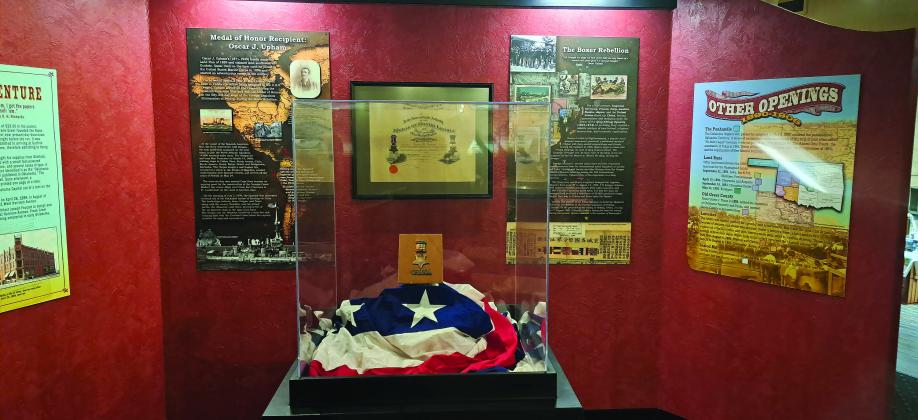This year marks the 50th anniversary of a key Guthrie landmark: the Oklahoma Territorial Museum. The museum opened in 1973 through the hard work of local philanthropist Fred Pfeiffer, for whom the main building of the museum is named, and includes the museum building as well as the adjacent Carnegie Library.
The museum itself provides a rich set of exhibits related to the early days of Guthrie and Oklahoma. Displays and exhibits cover the pre-Land Run history of the area and the Indigenous tribes, the Land Run itself and homesteading in the territory, a replicated Land Office showing how and where land run claims were filed, displays of the contributions of and challenges faced by African-Americans in the territory, histories of law enforcement and the press, and a layout demonstrating the path of Oklahoma Territory to full statehood.
The Carnegie Library building had served as Guthrie’s library since it was first built in 1902. Construction was enabled thanks to a grant from the Carnegie Foundation as part of its massive push in the late 19th and early 20th centuries to build libraries nationwide. Guthrie’s library building remains the oldest Carnegie Library still standing in Oklahoma, as well as the second oldest that was built in the state.
During its time as Guthrie’s main library the Carnegie building hosted many interesting historical figures and events, including the inaugurations of both the last territorial governor, Frank Frantz, in 1906, and first state governor, Charles Haskell, in 1907. Also, museum officials claim that onetime Guthrie resident Tom Mix
MUSEUM » PAGE 2 taught exercise classes in the library’s gymnasium. The library held regular and well-attended children’s story hours during the Great Depression, and maintained popular activities for teens in the 1950s and 1960s. These traditions of quality youth activities continue at Guthrie’s library to this day.
When Guthrie’s city leaders announced plans in 1972 to demolish the Carnegie Library and replace it with a new library building at the same location, Pfeiffer stepped in to preserve it. He offered to build a separate museum directly next to the library building in exchange for Guthrie not tearing it down. The city agreed to his proposal, saving the library and paving the way for a key landmark and tourist attraction. Eventually the museum and library buildings were joined and now coexist as the museum.
Notably, the museum contains a substantial exhibit regarding Elmer Mc-Curdy, an American outlaw and bank robber who lived in the early 20th century. He gained notoriety in 1911 after being killed by law enforcement during a robbery attempt, but his story did not end there. McCurdy’s mummified body was unclaimed by family and was eventually passed around as a novelty and sideshow attraction, appearing in carnivals and amusement parks for decades. McCurdy’s body was finally discovered in 1976 in a funhouse in Long Beach, California, where it had been used as a prop. Authorities identified Mc-Curdy’s body and he was finally returned to his home state, where he was given a proper burial in Guthrie’s Summit View Cemetary. The museum’s exhibit on McCurdy fully relates his story, with documents and newspaper articles of his crimes and his death, as well as the actual firearm used by law enforcement officials to kill him as he fought capture.
Also of note is the sizable exhibit telling the story of well-known temperance crusader Carrie Nation, who was a Guthrie resident for some time beginning in 1905. It was through her tireless efforts that Prohibition was originally built into the Oklahoma constitution from statehood, until it was repealed through popular vote in 1959. The museum’s exhibit on Nation features one of Nation’s hatchets, which she was famous for using in busting up local saloons.
The museum has plans and special events to mark the 50th anniversary but they have not yet released them.



